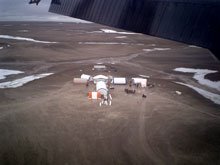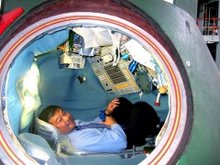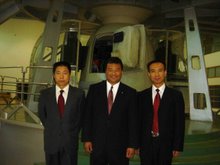

On April 19th, a Soyuz TMA spacecraft returned to Earth in the backup ballistic mode. This was the second Soyuz in a row to return in that mode. What does it all mean?
I flew on Soyuz TMA-5 to and from the International Space Station for Expedition 10. I was trained as the copilot, so I was intimately familiar with the spacecraft, it's operation, the backup modes and emergency procedures. Normally, the Soyuz descent module returns to Earth in an automatic mode, which flies a determined flight profile with closed-loop guidance. That is, the spacecraft is maneuvering to hit a defined point in the sky, where the parachute is deployed. In this maneuvering, the spacecraft profile is also designed to minimize the G-loading of the crew, usually to less than five G's. This was the case for TMA-5.
There are a number of failures that can cause a ballistic entry. In these cases, the spacecraft descent module spins and a rate of between thirteen and eighteen degrees per second, depending on the specific mode. There is no closed-loop guidance, the capsule is descending in a stable, but uncontrolled mode, to land where it is pointed. Thus, the footprint on possible landing sites is much larger. The crew is also subjected to higher G-loading, since the autopilot is not flying to minimize this loading. The maximum reported G on the last Soyuz was 8.2 G. This is a high level, but it is certainly tolerable. Anyone who flies on a Soyuz is run through the centrifuge to this level as a medical evaluation.
The real question is why did two Soyuz TMA's enter in ballistic mode? In the case of the first one, there appeared to be at least two failures, with a frayed wire causing a short being officially blamed for the downmoding of the spacecraft. We will have to wait for the incident report to find out what caused the latest downmode.
Is the Soyuz safe? I think so. I have met the people who work on the vehicles, I have seen for myself the environment in which they are created and processed. These are a dedicated group of specialists and they are very serious about what they do. The Soyuz design has been around for decades. It is the single most reliable spacecraft (with the largest number of flights) in history, to date.
I will be following this story closely.
Leroy Chiao







5 comments:
An aerial photo of of the Soyuz TMA-11 landing site shows a large area of burned soil and smoke. is the burned soil related to the Soyuz landing?
Actually, my understanding is that the fire was not due to the Soyuz. It was local farmers burning their crops after the harvest.
Leroy Chiao
I saw Soyuz TMA-12 crew during the press-conference in Zviozdniy. (http://foto.ng.ru/galleries/?269) Peggi looked very good especially after the hard landing. So I have a question. How much time does the rehabilitation period spend after a normal landing on Soyuz and Shuttle after a half-year mission on ISS? And I'd like to ask you, are there any chances to prolong Space Shuttle program after the 2010th? Or it's impossible because of shuttles old and represent a danger?
Rehabilitation following a spaceflight varies a lot by individual. In my case, it took about a week before I felt back to my old self after 6-1/2 months in space. Some crews take over a month to get to that point. I think we recovered quickly because we were very good about doing our exercises in space!
I don't believe the shuttle will be extended past 2010. The program has been systematically dismantled over the past few years and it would be extremely expensive to restart.
Leroy Chiao
Thanks for the explanation! I've been wondering of the implications, but it seems like despite having to use backup mode, the capsule operated successfully. The news media like to make the worst of the situation, so it's nice to hear a scientific and rational explanation.
Post a Comment